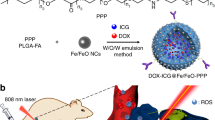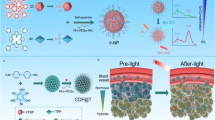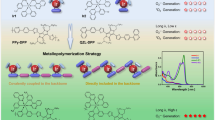Abstract
Luminescent materials are widely used for imaging and sensing owing to their high sensitivity, rapid response and facile detection by many optical technologies1. Typically materials must be chemically tailored to achieve intense, photostable fluorescence, oxygen-sensitive phosphorescence or dual emission for ratiometric sensing, often by blending two dyes in a matrix. Dual-emissive materials combining all of these features in one easily tunable molecular platform are desirable, but when fluorescence and phosphorescence originate from the same dye, it can be challenging to vary relative fluorescence/phosphorescence intensities for practical sensing applications. Heavy-atom substitution2 alone increases phosphorescence by a given, not variable amount. Here, we report a strategy for modulating fluorescence/phosphorescence for a single-component, dual-emissive, iodide-substituted difluoroboron dibenzoylmethane-poly(lactic acid) (BF2dbm(I)PLA) solid-state sensor material. This is accomplished through systematic variation of the PLA chain length in controlled solvent-free lactide polymerization3 combined with heavy-atom substitution2. We demonstrate the versatility of this approach by showing that films made from low-molecular-weight BF2dbm(I)PLA with weak fluorescence and strong phosphorescence are promising as ‘turn on’ sensors for aerodynamics applications4, and that nanoparticles fabricated from a higher-molecular-weight polymer with balanced fluorescence and phosphorescence intensities serve as ratiometric tumour hypoxia imaging agents.
This is a preview of subscription content, access via your institution
Access options
Subscribe to this journal
Receive 12 print issues and online access
$259.00 per year
only $21.58 per issue
Buy this article
- Purchase on Springer Link
- Instant access to full article PDF
Prices may be subject to local taxes which are calculated during checkout



Similar content being viewed by others
References
Yuste, R. Fluorescence microscopy today. Nature Methods 2, 902–904 (2005).
Lower, S. K. & El-Sayed, M. A. The triplet state and molecular electronic processes in organic molecules. Chem. Rev. 66, 199–241 (1966).
Zhang, G., Kooi, S. E., Demas, J. N. & Fraser, C. L. Emission colour tuning with polymer molecular weight for boron dibenzoylmethane-polylactide. Adv. Mater. 20, 2099–2104 (2008).
Köse, M. E., Omar, A., Virgin, C. A., Carroll, B. F. & Schanze, K. S. Principal component analysis calibration method for dual-luminophore oxygen and temperature sensor films: Application to luminescence imaging. Langmuir 21, 9110–9120 (2005).
Koo, Y. E. L. et al. Real-time measurements of dissolved oxygen inside live cells by organically modified silicate fluorescent nanosensors. Anal. Chem. 76, 2498–2505 (2004).
Zhang, G. et al. Multi-emissive difluoroboron dibenzoylmethane polylactide exhibiting intense fluorescence and oxygen sensitive room temperature phosphorescence. J. Am. Chem. Soc. 129, 8942–8943 (2007).
Scypinski, S. & Love, L. J. C. Room-temperature phosphorescence of polynuclear aromatic hydrocarbons in cyclodextrins. Anal. Chem. 56, 322–327 (1984).
Mitchell, C. A., Gurney, R. W., Jang, S.-H. & Kahr, B. On the mechanism of matrix-assisted room temperature phosphorescence. J. Am. Chem. Soc. 120, 9726–9727 (1998).
Carretero, A. S., Castillo, A. S. & Gutiérrez, A. F. A review of heavy-atom-induced room-temperature phosphorescence: A straightforward phosphorimetric method. Crit. Rev. Anal. Chem. 35, 3–14 (2005).
Chow, Y. L., Cheng, X. C. & Johansson, C. I. Molecular interactions of dibenzoylmethanatoboron difluoride (DBMBF2) in the excited and ground states in solution. J. Photochem. Photobiol. A 57, 247–255 (1991).
Cogné-Laage, E. et al. Diaroyl(methanato)boron difluoride compounds as medium sensitive two-photon fluorescent probes. Chem. Eur. J. 10, 1445–1455 (2004).
Nagai, A., Kokado, K., Nagata, Y. & Chujo, Y. 1,3-Diketone-based organoboron polymers: Emission by extending π-conjugation along a polymeric ligand. Macromolecules 41, 8295–8298 (2008).
Qin, Y., Kiburu, I., Shah, S. & Jäkle, F. Synthesis and characterization of organoboron quinolate polymers with tunable luminescence properties. Macromolecules 39, 9041–9048 (2006).
Pfister, A., Zhang, G., Zareno, J., Horwitz, A. F. & Fraser, C. L. Boron polylactide nanoparticles exhibiting fluorescence and phosphorescence in aqueous medium. ACS Nano 2, 1252–1258 (2008).
McClure, D. S. Triplet–singlet transitions in organic molecules. Lifetime measurements of the triplet state. J. Chem. Phys. 17, 905–913 (1949).
Adachi, C., Baldo, M. A., Thompson, M. E. & Forrest, S. R. Nearly 100% internal phosphorescence efficiency in an organic light-emitting device. J. Appl. Phys. 90, 5048–5051 (2001).
Baldo, M. A., O’Brien, D. F., Thompson, M. E. & Forrest, S. R. Excitonic singlet–triplet ratio in a semiconducting organic thin film. Phys. Rev. B 60, 14422–14428 (1999).
Twarowski, A. J. & Good, L. Phosphorescence quenching by molecular oxygen: Zinc tetraphenylporphin on solid supports. J. Phys. Chem. 91, 5252–5257 (1987).
Höckel, M. & Vaupel, P. Tumor hypoxia: Definitions and current clinical, biologic, and molecular aspects. J. Natl Cancer Inst. 93, 266–276 (2001).
Harris, A. L. Hypoxia—a key regulatory factor in tumour growth. Nature Rev. Cancer 2, 38–47 (2002).
Dewhirst, M. W. et al. Review of methods used to study oxygen transport at the microcirculatory level. Int. J. Cancer 90, 237–255 (2000).
Sorg, B. S., Moeller, B. J., Donovan, O., Cao, Y. & Dewhirst, M. W. Hyperspectral imaging of hemoglobin saturation in tumor microvasculature and tumor hypoxia development. J. Biomed. Opt. 10, 44004 (2005).
Baran, J., Duda, A., Kowalski, A., Szymanski, R. & Penczek, S. Intermolecular chain transfer to polymer with chain scission: General treatment and determination of kp/ktr in L, L-lactide polymerization. Macromol. Rapid Commun. 18, 325–333 (1997).
Save, M., Schappacher, M. & Soum, A. Controlled ring-opening polymerization of lactones and lactides initiated by lanthanum isopropoxide, 1. General aspects and kinetics. Macromol. Chem. Phys. 203, 889–899 (2002).
Crosby, G. A. & Demas, J. N. Measurement of photoluminescence quantum yields. J. Phys. Chem. 75, 991–1024 (1971).
Melhuish, W. H. Quantum efficiencies of fluorescence of organic substances: Effect of solvent and concentration of the fluorescent solute. J. Phys. Chem. 65, 229–235 (1961).
Acknowledgements
We thank the National Science Foundation (C.L.F.: CHE 0718879), the Department of Defense (G.M.P.: Postdoctoral Fellowship W81XWH-07-1-0355) and the NIH (M.W.D.: R01CA40355) for support for this research. We are also grateful to the UVA NanoSTAR Institute and the UVA Cancer Center through the James and Rebecca Craig Foundation and the NCI Cancer Center Support Grant P30 CA44579 for supporting our efforts to develop and test BNPs as biomedical imaging agents. We thank J. N. Demas for helpful discussions and R. E. Evans for assistance.
Author information
Authors and Affiliations
Contributions
G.Z and C.L.F. are responsible for materials design, synthesis and characterization and manuscript preparation. G.M.P. and M.W.D. are responsible for tumour hypoxia imaging studies and data analysis.
Corresponding author
Supplementary information
Supplementary Information
Supplementary Information (PDF 486 kb)
Rights and permissions
About this article
Cite this article
Zhang, G., Palmer, G., Dewhirst, M. et al. A dual-emissive-materials design concept enables tumour hypoxia imaging. Nature Mater 8, 747–751 (2009). https://doi.org/10.1038/nmat2509
Received:
Accepted:
Published:
Issue Date:
DOI: https://doi.org/10.1038/nmat2509
This article is cited by
-
Multicolor hyperafterglow from isolated fluorescence chromophores
Nature Communications (2023)
-
Room temperature phosphorescence from natural wood activated by external chloride anion treatment
Nature Communications (2023)
-
Aggregation-regulated room-temperature phosphorescence materials with multi-mode emission, adjustable excitation-dependence and visible-light excitation
Nature Communications (2023)
-
Anti-Kasha triplet energy transfer and excitation wavelength dependent persistent luminescence from host-guest doping systems
Nature Communications (2023)
-
A direct observation of up-converted room-temperature phosphorescence in an anti-Kasha dopant-matrix system
Nature Communications (2023)



